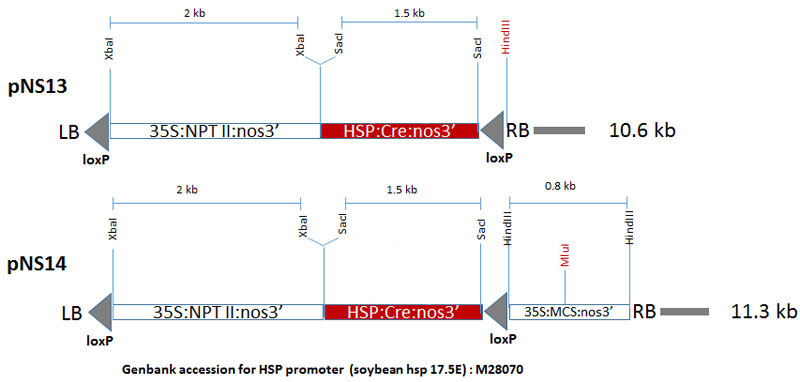Marker-Free Transgenic Plant Vectors
Marker-Free Transgenic Plant Vectors allow for excision of a selection marker gene in primary transgenic plants by heat shock treatment and are suitable for transformation of plants with Agrobacterium tumefaciens.
Highlights:
- pNS13: for cloning full gene (promoter:gene:terminator) into HindIII site
- pNS14: for cloning cDNA into MluI sites (to be expressed by 35S promoter)
- Binary Vector backbone: pPZP200 (spectinomycin selection)
- Plant selection: NPT II gene (Kanamycin or Geneticin)
- Excision system: Cre-lox recombination
- Autoexcision system: Heat-inducible Cre-lox recombination
From the laboratory of Vibha Srivastava, PhD, University of Arkansas, Division of Agriculture.
 Part of The Investigator's Annexe program.
Part of The Investigator's Annexe program.
Marker-Free Transgenic Plant Vectors allow for excision of a selection marker gene in primary transgenic plants by heat shock treatment and are suitable for transformation of plants with Agrobacterium tumefaciens.
Highlights:
- pNS13: for cloning full gene (promoter:gene:terminator) into HindIII site
- pNS14: for cloning cDNA into MluI sites (to be expressed by 35S promoter)
- Binary Vector backbone: pPZP200 (spectinomycin selection)
- Plant selection: NPT II gene (Kanamycin or Geneticin)
- Excision system: Cre-lox recombination
- Autoexcision system: Heat-inducible Cre-lox recombination
From the laboratory of Vibha Srivastava, PhD, University of Arkansas, Division of Agriculture.
 Part of The Investigator's Annexe program.
Part of The Investigator's Annexe program.
| Catalog Number | Product | DataSheet | Size | AVAILABILITY | Price | Qty |
|---|
Specifications
| Product Type: | Plasmid |
| Gene/insert name: | pNS13, pNS14 |
| Accession ID: | M28070 |
| Antibiotic Resistance: | pPZP200 (spectinomycin selection); NPT II gene (Kanamycin or Geneticin) |
| Format: | Liquid (Domestic shipments), Spotted Filter Paper (International shipments) |
| Vector Backbone and Size: | pPZP200; 10.6kb (pNS13), 11.3kb (pNS14) |
| Storage: | Long term -20C |
| Shipped: | Ambient temperature |
Research
Plant Transformation Vectors

Between the loxP sites there are two fragments: (1) XbaI fragment containing 35S:NPT:nos3', (2) SacI fragment containing HSP:Cre:nos3'. Outside is a HindIII 35S::nos3' fragment with a unique cloning site, MluI.
Provider
From the laboratory of Vibha Srivastava, PhD, University of Arkansas, Division of Agriculture.
References
- Nandy S, Srivastava V. Marker-free site-specific gene integration in rice based on the use of two recombination systems. Plant Biotechnol J. 2012 Oct;10(8):904-12.
If you publish research with this product, please let us know so we can cite your paper.


